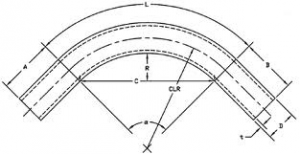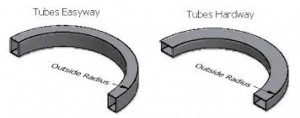There are several parameters to know for performing tube bending:
1. Radius for the bend section – CLR
2. Chord of the bend section – C
3. Arc length – L
4. Degree of bend – a
5. Rise of bend section – R
6. Tube size – D
7. Wall thickness – t
8. Tangents – A, B
Not all are necessary to be known but at least three are needed to produce a correct tube bend.
Even though procedures are the same for bending all tubes, square end rectangular tubes require special consideration. Things like square versus round corners, location of the weld seam, shop-fabricated versus mill-produced materials, hard way versus easy way, size of the material, wall thickness, and radius of bend. Location of the weld seam and the corner radii are required for proper mandrel fitting into the inside of the tube.For shop fabricated materials square or rectangular corner edges become work-hardened which may cause difficulty bending.
Bending rectangular tube the hard way produces less distortion or concavity then bending the easy way especially when the difference between the sides of the tubing is greater. There is a greater chance for distortion in the larger tubes bent to a smaller radius than for the smaller tubes bent to a larger radius.

Bending round, square, or rectangular tubes requires stretching of the outside diameter of the bend and compressing inside diameter. The heavier the wall thickness, the tighter the bend radius that can be achieved with less distortion.If tubes are to be architecturally exposed then more consideration is required to produce the clean bend.
All this information is a key for choosing the appropriate method of tube bending which may be rotary draw bending, roll bending, incremental bending, or heat induction bending. The more parameters are known, the better the bending method can be chosen which will produce the best final results: accurate bends without distortion.









